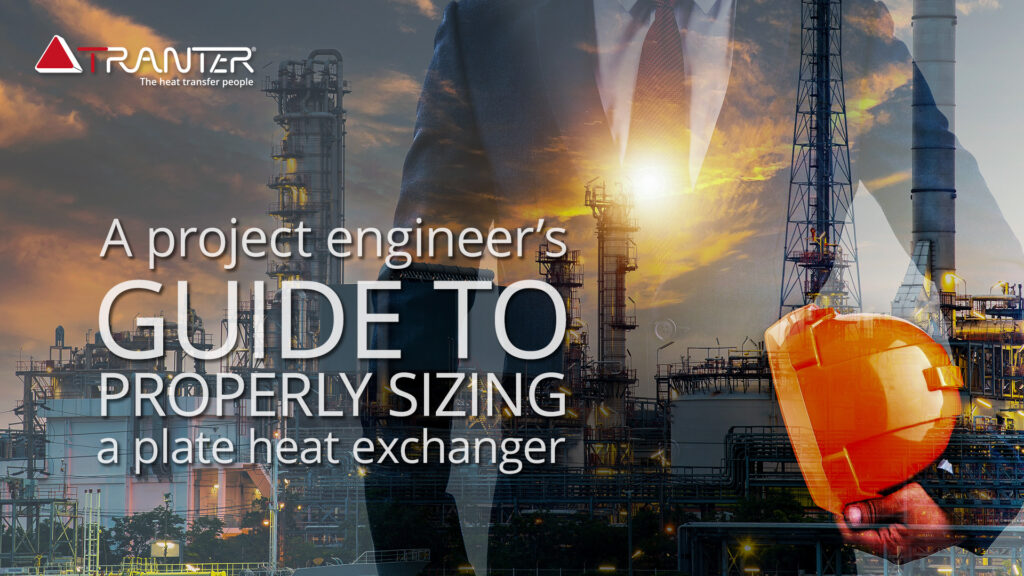A Project Engineer’s guide to properly sizing a plate heat exchanger

Mastering the complexities of plate heat exchangers is not just about understanding their operational nuances but also ensuring they align perfectly with your heating and cooling system’s needs. But, as any seasoned engineer knows, a heat exchanger isn’t a one-size-fits-all solution. Its efficiency, longevity, and overall performance hinge on its proper sizing. Here’s how to approach the process and ensure a good fit.
Size matters
Yes, sizing your plate heat exchanger (PHE) correctly is pivotal. Missteps can have ripple effects, while the right choice brings drastic benefits. Let’s break down the implications of each scenario:
The consequences of improper sizing:
- Inefficiency: An incorrectly sized plate heat exchanger won’t meet your required heat transfer demands. This inefficiency has cascading effects on your heating and cooling system’s performance.
- Cost implications: Oversizing can make your exchanger more expensive than necessary – both in its initial cost and operational expenses. Underestimating its size, conversely, results in a unit that doesn’t fulfil your system’s needs.
- Operational shortcomings: Improper sizing might not only underperform but also introduce flaws. These flaws ripple through your heating and cooling system, affecting quality, consistency, and, ultimately, the bottom line.
The rewards of right-sizing:
- Small footprint: A well-sized PHE will be inherently compact. It won’t waste valuable floor space, making it an ideal fit for plants where space is at a premium.
- Cost-savings: The right size ensures that the plates within the exchanger are optimized. This leads to efficient heat transfer, reducing energy costs, which, in the long run, translates to tangible savings.
- Extended maintenance periods: When your PHE operates within its design parameters, it reduces wear and tear. This results in the exchanger remaining functional for longer periods without intervention.
- Efficiency: A properly sized plate heat exchanger ensures seamless integration into your heating and cooling system’s processes. This not only enhances your exchanger’s efficiency but also boosts the overall system’s performance.
Key factors in sizing a plate heat exchanger
Sizing a plate heat exchanger is more than just fitting a piece of machinery into your heating and cooling system. It’s about figuring out how this component will influence and be influenced by many different variables in your operations. So, here’s a roadmap of key factors to consider when sizing your exchanger:
1. Define clear objectives:
- Temperature dynamics: What are your starting and target temperatures? It’s essential to pinpoint these to ensure effective heat exchange.
- Flow rate: Anticipate the flow volume. This factor can’t be overlooked, as it directly impacts the PHE’s efficiency and your operation’s overall productivity.
- Operational limits: What maximum temperature and pressure will the exchanger encounter? These determine the robustness and safety margins of your equipment.
2. Adhere to norms and standards:
- Safety margins: Build in allowances. Your heat exchanger should be agile and capable of handling both the routine and the extraordinary.
- Tailored requirements: Does your operation need any special PHE features or designs?
- Compliance codes: Don’t just adhere; excel! Know the design codes pertinent to your operation and ensure your PHE exceeds them.
- Geographical specifications: Every physical location comes with its own set of safety and environmental standards. Dive into the specifics of your operational region.
- Local nuances: Sometimes, it’s the hyper-local guidelines that can be the most stringent. Ensure your PHE is attuned to any localized stipulations.
3. Contextual awareness:
- Geographical concerns: A PHE’s physical location can dictate its design. For example, being near the sea might necessitate corrosion-resistant materials.
- Industry demands: Tailor your PHE to your sector. A dairy processing unit’s PHE, for instance, has starkly different requirements from one used in a petrochemical plant.
- Operational patterns: Understand your PHE’s role. Is it for round-the-clock operations or periodic usage?
| PRO TIP: Want to take it one step further?To truly optimize your plate heat exchanger’s sizing, going beyond the basics can make a difference. After covering the main points above, consider diving deeper into these refinements to fine-tune the fit for your operations:Use advanced technology: Go beyond basic calculations using current technology to study duty and temperature profiles. This tech provides key insights, especially for complex fluid properties. Component compatibility: PHE efficiency isn’t just about size. Select plates and gaskets based on operational demands to ensure a well-functioning system.Utilize modern design tools: Modern design software offers enhanced accuracy in PHE sizing. Don’t shy away from using these tools for detailed insights and tailored solutions. Focus on component integration: It’s essential to see the bigger picture. How will the ports, plates, and pressure ratios complement each other? Aim for an interconnected system where each part enhances the overall functionality. Marry thoroughness with efficiency: Use modern tools and methods for precise PHE sizing without lengthy analysis. Aim for a balanced approach for the best results. |
Work with the right supplier (and utilize their expertise)
All in all, getting the size right for a plate heat exchanger is tricky – especially without help or the technical knowledge necessary to ensure success. Designs that seem great on paper can hit snags in real life. That’s why it’s essential to work with a supplier who can support you through each step of the sizing process.
By working together, you’ll fit the heat exchanger into your project smoothly. And remember, the right supplier sticks around even after the sale. They’re there to help, give advice, and make sure things run smoothly. Utilize it!
You don’t have to size your exchanger alone. Why leave anything to chance when the best supplier in the business is just a call away? Reach out to our expert engineers today and let us help you turn sizing challenges into optimized solutions.
